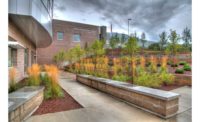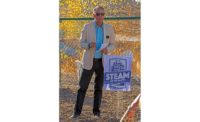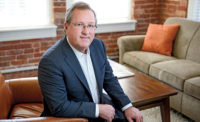Elk, antelope, pheasant and trout may all have become more wary since Bob Thompson has had some time on his hands.
Thompson, chairman and CEO emeritus of Denver-based geotechnical consulting engineer CTL | Thompson, has been spending more hours outside the office after retiring five years ago. Still, the enthusiastic outdoorsman has continued to consult regularly with the company and train young engineers, even as he has devoted himself to hunting and fishing, sampling wines from around the world and tinkering on his prized 1963 Porsche 356B Super 90. At 79, he only recently gave up ski racing, a passion since his teenage years.
Meanwhile, his lifelong engineering achievements, which span more than five decades, have earned him an ENR Mountain States 2017 Legacy Award. The honor is given annually by ENR’s regional editors to professionals who have demonstrated a lifetime of service both to the AEC industry and the community.
Thompson’s most notable breakthroughs have been in the fields of expansive and collapsing soils. Over the years, he’s worked to develop techniques for both predicting and minimizing soil expansion.
He’s also committed himself to sharing information and pushing the boundaries of the profession through the Colorado Association of Geotechnical Engineers (CAGE), which he helped to establish in 1995, as well as the American Society of Civil Engineers (ASCE) and other organizations. He was national president and an eight-year board member of the Geoprofessional Business Association (formerly the Association of Soil and Foundation Engineers) and a founding trustee of the Academy of Geoprofessionals, a part of ASCE.
CTL | Thompson Vice President Marc Cleveland estimates the company has played a role in nearly 100,000 residential and commercial building projects since opening its doors, in 1971, as Robert W. Thompson Inc. Now with nine offices and more than 240 employees in Colorado and Wyoming, CTL | Thompson is the largest full-service geo-technical, structural, environmental and materials engineering firm headquartered in Denver.
The company took its current name after acquiring Commercial Testing Laboratories, a materials engineering and testing firm, in 1977. A majority of its projects involve expansive soils, which are common in the Denver area, along Colorado’s Front Range and on the state’s eastern plains.
In 1967, following completion of his master’s degree in civil engineering from Oklahoma State University two years earlier, Thompson became chief engineer for Chen & Associates, Denver, and came under the mentorship of Fu Hua Chen, an early investigator of Colorado’s expansive soils. Working with Chen, Thompson continued a process he had begun in graduate school, comparing preconstruction estimates of soil movement with actual outcomes to determine how well the engineers’ predictions were working.
“I spent a lot of time measuring over the years,” Thompson says. “I found stuff that worked and stuff that didn’t work and tried to relate the predictions with what we found on the ground. And that’s how we gradually improved the predictions. Once you get a better handle on the prediction, you’ve got a better chance of getting the structure to perform the way you want it to.”
The basic problem associated with expansive soils is that they absorb water and swell, shifting and cracking foundations, patios and lighter structures, such as homes, schools and churches, Thompson explains. Nonetheless, Colorado’s famously snowy climate is relatively dry, and dry soils can take on water and expand, too.
“Think of it this way,” Thompson says. “If you put a dry sponge in a pan of water, it will suck up the water. It’s the same thing with soils.”
Soil Repair
It was around 1992 that Thompson hit upon an idea that would greatly influence the way engineers deal with both expanding and collapsing soils. For a housing development north of Golden, Colo., Thompson had crews over-excavate the expansive soil, down to a depth of 16 ft. Next, he had them add water until the soil no longer showed a tendency to swell. Workers put the soil back, then compacted it and started to build.
“And it worked,” Thompson says with satisfaction.The technique has been widely used and substantially decreased the performance problems of structures built upon the Front Range’s expansive soils.
Thompson wanted to spread the word. In 1995, helped to start the organization that eventually became CAGE. By sharing ideas and information, he hoped to turn competitors into colleagues and upgrade the soil-engineering profession.
“This may sound strange,” he says, “but I think the best thing that happened is that these guys all got in the same room and found out the other guy wasn’t such a bad person. I think it’s good for the community to be dealing with each other professionally, instead of just hatcheting the other guy, to try to make things more uniform and inform people of the risks they need to avoid.”
Through his association work, Thompson has strived to influence the curricula at engineering schools so that graduates have the skills the industry needs.
One young professional who has stayed with Thompson’s firm nearly all his career is Cleveland, who started as a technician in 1975, earned his engineering degree in 1981 and worked his way up to his current VP position. He says his story is not unusual in the company, which is known for retaining people over the decades. Cleveland says the culture that Thompson fostered is both challenging and rewarding.
“Working for Bob, you had to think,” Cleveland says. “He didn’t want to see any haphazard guessing. He wanted a good report. He wanted you to have thought through it. If it was a poor performance, he would throw it back in your face and say, ‘Go rewrite this.’ ”
“Sometimes the language was colorful, but he got my attention and other engineers’ attention,” Cleveland says. “He wanted us to be thorough and thoughtful in our evaluations and to interrelate with the client. You look at all the other competitors that he had in the area, and there wasn’t a better firm to work for and no one more knowledgeable.”
“Bob only has a master’s degree, but through his work in the business he’s earned a number of PhDs, if you will,” Cleveland continues. “He also set up the process that has allowed the ownership of CTL | Thompson to transition from himself to a second generation of employees, then to a third and now a fourth generation.”
Adds E.J. Olbright, CEO of CFC Construction in Golden, “He was the kind of guy that you could call with a problem that nobody else could solve. When you’re building in the mountains of Colorado, you have all kinds of problems in the geotechnical world. He just had a real knack for creating solutions that were practical, cost-effective and ironclad. We need more Bobs in this world.”





